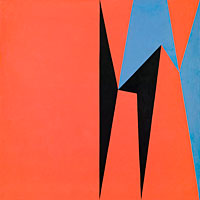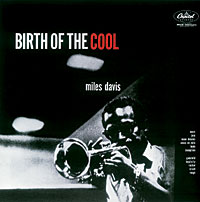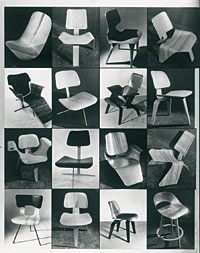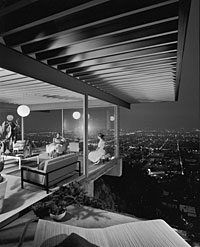From painting and architecture to music, film, furniture and the graphic arts, 1950s Los Angeles was an epicenter of American modernism. This fall the Mildred Lane Kemper Art Museum at Washington University in St. Louis will present Birth of the Cool: California Art, Design, and Culture at Midcentury, a sprawling multimedia exhibition that investigates how the sleek West Coast aesthetic — at once playful and poised, laid-back and sharply articulated — emerged as cultural shorthand for crisp sophistication.

Organized by the Orange County Museum of Art, Birth of the Cool — named for the groundbreaking 1957 album by Miles Davis — includes more than 200 objects exploring the influences, relationships, and affinities that bound together a disparate group of artists from a variety of fields and backgrounds. The installation, echoing the period it covers, includes a jazz lounge; a gallery of abstract paintings; and a media bar with film, animation and television programming. Also on view will be a variety of archival and documentary images, as well as an interactive timeline and a gallery devoted to modern furniture and design.
In the 1930s and 1940s Los Angeles attracted artists and intellectuals from across the United States and, critically, from Europe. Many of these new arrivals, fleeing the impending war, brought with them tenets of international modernism and found employment and safe haven in Hollywood. The experimental German filmmaker Oskar Fischinger was recruited to Paramount and later worked at MGM and Disney, while the Hungarian-born Jules Engel helped launch the United Productions of America Studio, which pioneered the flat, graphic style of midcentury animation with cartoons such as Gerald McBoing Boing (1950).
By the 1950s the Hollywood Hills were dotted with modernist residences by architects such as Pierre Koenig, John Lautner and Richard Neutra. Constructed largely of glass and steel, these light-filled homes — many commissioned by Art & Architecture’s Case Study House program — were open to the elements, with walls and ceilings that seemed to float in space. A similar sense of spatial instability informed the “hard edge” painting of Karl Benjamin, Helen Lundeberg, Lorser Feitelson, Frederick Hammersley and John McLaughlin. These colorful geometric abstractions, with their ambiguity between flatness and depth, stood in sharp contrast to the gestural and emotive fervency of New York abstract expressionism.

Meanwhile the “cool jazz” of Miles Davis, conceived in reaction to then-dominant bebop, helped define “cool” for a national and global audience, and was an important influence on West Coast players such as Chet Baker, Dave Brubeck, June Christy, Shelly Manne, Gerald Mulligan, Art Pepper and Sonny Rollins. Portraits and album covers by photographer William Claxton captured the movement’s sense of effortless grace, just as architectural photographer Julius Shulman helped popularize the modernist home through carefully staged scenes of middle-class suburban couples living amidst high Hollywood style.
Perhaps no figures better exemplify the creativity and optimism of California cool than designers Charles and Ray Eames. Born and raised in St. Louis, Charles Eames studied architecture at Washington University from 1925-27 and later taught at Michigan’s Cranbrook Academy of Art, where he met Ray Kaiser, a Sacramento native. In 1941 the couple married and moved to Los Angeles, where they spent the next four decades reshaping American design. Their molded-plywood furniture, plastic chairs and iconic lounge — all showcased in the exhibition, along with rare film clips and other archival materials — joined pioneering technologies with a rigorous yet lighthearted sensibility, creating works that were innovative, affordable and accessible.

EVENTS
In conjunction with Birth of the Cool the Kemper Art Museum will offer free afternoon jazz concerts on select Saturdays throughout the fall as well as talks by Elizabeth Armstrong, chief curator for the Orange County Museum of Art (Sept. 20); Terry Smith, professor of contemporary art history and theory at the University of Pittsburgh (Oct. 13); and Thomas Crow, professor of modern art at New York University (Nov. 7). Eric Mumford, associate professor of architecture in the Sam Fox School of Design & Visual Arts and author of Modern Architecture in St. Louis, will lead a tour of area landmarks Oct. 5. The museum also will present Some Like It Cool, a film series that will include screenings of Rebel Without a Cause (Dec. 9), Anatomy of a Murder (Dec. 10) and North by Northwest (Dec. 11).
SPONSORS
Major support for Birth of the Cool is provided by Brent R. Harris, The Segerstrom Foundation and the National Endowment for the Arts, a federal agency. Significant support is provided by Bente and Gerald Buck, Twyla and Chuck Martin, Jayne and Mark Murrel, Pam and Jim Muzzy, Barbara and Victor Klein, and Victoria and Gilbert E. LeVasseur Jr. Additional support is provided by Toni and Steven Berlinger and Patricia and Max Ellis. Corporate Sponsorship is provided by Gucci and Design Within Reach.
Local exhibition supporters include the Missouri Arts Council, a state agency; the Regional Arts Commission; James M. Kemper, Jr.; the David Woods Kemper Memorial Foundation; the Hortense Lewin Art Fund; Centro Modern Furnishings; and individual contributors to the Kemper Art Museum.

MILDRED LANE KEMPER ART MUSEUM
The Mildred Lane Kemper Art Museum, part of Washington University’s Sam Fox School of Design & Visual Arts, is committed to furthering critical thinking and visual literacy through a vital program of exhibitions, publications and accompanying events. The museum dates back to 1881, making it the oldest art museum west of the Mississippi River. Today it boasts one of the finest university collections in the United States.
Birth of the Cool: California Art, Design, and Culture at Midcentury will open with a reception from 7 to 10 p.m. Friday, Sept. 19, 2008, and remain on view through Jan. 5, 2009. Both the reception and exhibition are free and open to the public.
The Kemper Art Museum is located on Washington University’s Danforth Campus, near the intersection of Skinker and Forsyth boulevards. Regular hours are 11 a.m. to 6 p.m. Mondays, Wednesdays and Thursdays; 11 a.m. to 8 p.m. Fridays; and 11 a.m. to 6 p.m. Saturdays and Sundays. The museum is closed Tuesdays. For more information, call (314) 935-4523 or visit kemperartmuseum.wustl.edu.
*Editor’s Note: High-resolution images are available upon request.
|
WHO: Mildred Lane Kemper Art Museum WHAT: Exhibition, Birth of the Cool: California Art, Design, and Culture at Midcentury WHEN: Sept. 19, 2008, to Jan. 5, 2009. Opening reception 7 to 10 p.m. Friday, Sept. 19. WHERE: Mildred Lane Kemper Art Museum, Washington University, near the intersection of Forsyth and Skinker boulevards. HOURS: 11 a.m. to 6 p.m. Monday, Wednesday and Thursdays; 11 a.m. to 8 p.m. Fridays; 11 a.m. to 6 p.m. Saturdays and Sundays. Closed Tuesdays. COST: Free and open to the public. INFORMATION: (314) 935-4523 or www.kemperartmuseum.wustl.edu |